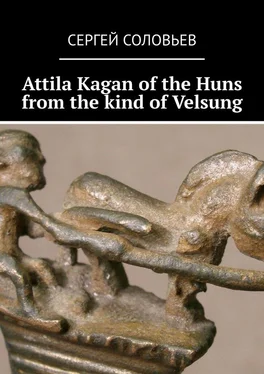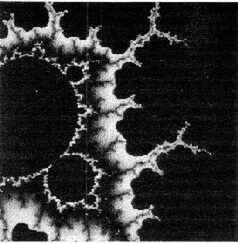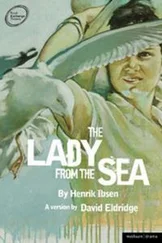
Figurine, man rides a horse on skis
Genetic studies of Andronov’s remains showed that the culture representatives had the Y chromosome haplogroup R1a1, R1b M73, Q1a and the Y chromosome haplogroup C (prd M48) and mitochondrial haplogroups U, Z, T, H, K, and HV. In one study of 2015, the Y chromosome haplogroup R1a1a1b2a2-Z2124 and mitochondrial haplogroups U2 were found, in another study of 2015, a mitochondrial haplogroup A10 * was found in a representative of the Fedorov culture (Tartas-1). The closest to Andronovites were representatives of the European culture of cord ceramics and Sintashta culture, as well as modern Indian populations, according to a study by Keyser C. et al. “Ancient DNA provides new insights into the history of south Siberian Kurgan people.”
What did all these peoples call themselves? I would venture to suggest that the Huns or Ghans, or rather, the Hans, and this is confirmed by the myth of Hannimed of Asia Minor. King Guney of Thessaly, as well as the names of the barrows in Russia and Germany, and in Russia, this literally means “KUR-GAN” – “possession of the Gans”, hens – possession, the cossack’s hens, and the name of the city of Kursk. And in Germany there are also such “Hünegrab” – “grave of the hun (giant)” and “Hünebett” – “the bed of the hun (giant)”. In Dutch also – Hunebed – a giant’s bed. It is very likely that it was at this time, and these peoples. Judging by the legends of the Narts and the legends of the Egyptians, the Huns-Hans were mysterious Hyksos-shepherd kings, because the cities founded by these tribes in the Nile Delta were given names in honor of the distant ancestral home – Tanais (Tanis) and Avaris, and here on the historical stage go Avars Avars, who became the ancestors of the current Avars.
Next comes the time of the Cimmerians, the predecessors of the Scythians. Although judging by the images of this people by the Greeks, they are indistinguishable from each other. Cimmerians (Akkad. Gimirāia, other Greek Κιμμέριοι) are nomadic tribes that invaded Transcaucasia in the second half of the VIII century BC. e. and in the 7th century BC e. conquered some areas of Asia Minor. Also the conditional name of the so-called “pre-Scythian” peoples of the Northern Black Sea region of the Iron Age. Gimirra from Assyrian sources can be identical to the Cimmerians of ancient authors, driven out from the steppes to the Middle East by the advance of the Scythians. By the way, now there is the city of Gyumri in the Caucasus in Armenia, and the city of Kimry in Russia, and the village of Gimry in Dagestan. The period of existence of the ethno-cultural community of the Cimmerians fell on the 1st half of the 1st millennium BC. e., according to ancient narrative sources and modern archaeological data, the traces of the Cimmerians are fairly reliably traced in the VIII – VII centuries BC. e. The region of residence of the Cimmerians is the Northern and Eastern Black Sea (Crimea, Priazovye, Taman, the western Ciscaucasia and the Caucasus); there is also information about the penetration of the Cimmerians into western Transcaucasia and Asia Minor.
In the 1st millennium BC. e. on the territory of Eurasia, an important historical era has come – the end of the Bronze Age and the beginning of the Iron Age. Written testimonies of the Cimmerians were preserved among the peoples who had written language who directly came into contact with them: in the chronicles of the Assyrians, in the Urartian and Biblical texts, in ancient authors.
Data on the language of the Cimmerians is limited to the tribal name itself and 3 names of their leaders; Iranian etymologies were proposed for all these words, not one of which is indisputable. Given the cultural affinity of the Cimmerians and Scythians according to written sources and archeological data, it is usually assumed that their languages belong to the Iranian language group, although rather to the Indo-Aryan. One of the first mentions of the Cimmerians is known from the ancient Greek Odyssey, probably created in the VIII century BC. In a poem traditionally attributed to the legendary Homer, the Cimmerians (dr. Greek Κιμμέριοι, Kimmerioi) and their lands are characterized in the light of mythological representations of the Hellenes and are localized in the Far West near the world river Ocean, where the rays of the sun-Helios never penetrate. The Cimmerians are mentioned in the poem only once in the eleventh song (“Victims for Calling the Dead” / “Summoning Shadows”).Translation options with this passage (lines 13—19):
“Soon we came to the deep waters of the Ocean;
Tam kimmerian sad area, covered forever
Wet fog and mist of clouds; never shows
The eye of the people there faces radiant Gelios, the land of
He leaves, ascending the stars, abundant sky,
He descends from heaven, abundantly with stars, turning to the earth;
A joyless night there from time immemorial surrounds the living.”
translation of Zhukovsky, Odyssey
Here Homer draws us a place where it is obvious that the Cimmerians lived earlier, before coming to the Black Sea, and this information is all the more valuable to us, because they paint us a picture of the Far North. But the Cimmerians in the seventh century BC, or rather a part of them, crossed the Caucasus Range and fell into the thick of historical events. penetrated into the Caucasus from the steppe zone and were in 714 BC. e. recorded by Assyrian texts under the name of the people “gimirru”. The data obtained from the analysis of the archives of Sargon II, Assarhaddon and Ashurbanipal are as follows. In 714 BC e. Cimmerians are fixed in the area north or northwest of Lake Sevan, and that in the previous period they paid tribute to Urartu. King Urartu Rus I made the next campaign against the nomads and suffered a major defeat, as a result of which many noble people were captured. At the same time, the Cimmerians attacked the Washi region adjacent to Manna, in the region of Lake Urmia. After these events, the Cimmerians are not mentioned in the Assyrian texts for 35 years. In the 660s BC e. they increase the onslaught of Lydia, as a result of which King Gig turned to Assyria for help. Soon the Lydians managed to defeat the Cimmerians, who for some time secured the kingdom. At this time, the nomads managed to tear away a number of Western territories from Assyria, which made Ashurbanipal consider them to be very dangerous opponents. Strengthening, the Cimmerians, led by King Dugdammi (Tugdamme; Ligdamis of the Greek texts) in 644 BC. e. again attack Lydia, as a result of which the Sardis were taken and King Gig was killed. At this time, there was the only clash between the Greeks and the Cimmerians, who managed to capture some of the cities of Ionia, in particular Magnesia-on-Meander and, apparently, Ephesus (according to Archilochus, the Cimmerians ravaged the Temple of Artemis in Ephesus). The stronghold of the conquerors in the west of Anatolia was Antander, which later even received the name Kimmerida. But for the permanent resettlement of his fellow tribesmen, Tugdamme chose the more distant Cappadocia. Soon, new attacks were launched on Assyria, but during one of these campaigns, King Dugdammi died of an illness (Strabo assumed that Tugdamme was defeated and killed by the Scythian king Madiy; Ashurbanipal claims that God Marduk defeated Tugdamme), and the Cimmerians retreated. His heir Sandakurr (Sandakshatra), also called the king of the Scythian Saks, is referred to as the enemy of Assyria in one of the texts of Ashurbanipal, but the nomads were no longer able to regain their power. They are no longer mentioned in Assyrian documents.
Читать дальше













